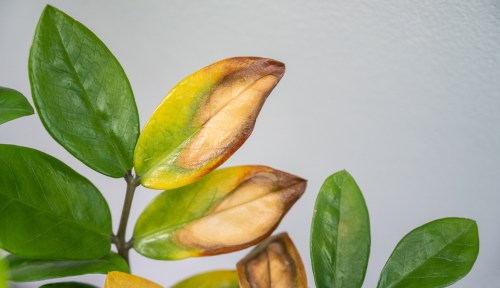Whether you’re a bonafide plant lady or a known succulent killer, you know that caring for your plants is not an easy feat. You can do all the right things—you water them at the best time of the day, put them near a window, incorporate them into your self-care routine, use fancy grow lights, and yet, sometimes, despite all your best efforts, their plant leaves are turning yellow.
Experts in This Article
horticulturist and resident plant mom at Bloomscape
plant consultant at The Well
professional gardener and founder of The Brown Thumb
To help solve our plant conundrum, we turned to a couple of green-thumbed pros to find out why (dear God, why?) those plant leaves are turning yellow (there are seven common reasons) and what you can do to keep your potted pals looking lush and oh so green.
Why are my plant leaves turning yellow?
Unfortunately, there’s no one reason as to why your plant’s leaves might be turning yellow. Yellowing leaves are often a sign of stress, and that stress can occur for a number of different reasons, outlined below.
1. The plant needs more water
When a plant’s roots aren’t getting enough water, it can cause plant leaves to start turning yellow. This can happen if you’re just watering the top of the soil or going too long in between watering sessions.
How to fix it: Joyce Mast, Bloomscape’s “plant mom,” recommends soaking the bottom of the plant by filling up your sink with 2-4 inches of water and setting the plant in there for 30 minutes. This will allow it to soak up the water from the bottom. Next, drain the sink and let the plant rest there for a bit to let excess water trickle down. Repeat every four weeks.
2. The plant is overwatered
The color and tone of the yellow can also give you some clues as to what your plant needs. If the yellow leaves look dull and lifeless, Luz LeStrange, plant consultant at The Well, says that could mean your plant is getting too much water. Roots need air just like we do, Mast adds. And when we get a little water-happy, the plant’s roots might not get enough air and start to drown and rot.
How to fix it: Cut back on the H20. LeStrange also suggests taking a sharp object (scissors, chopsticks, etc.) and probing the soil to let air in and let it breathe. This aeration of the soil will promote better air flow, allowing the soil to fully dry out in between waterings.
According to Monique Leonard-Segovia, professional gardener and founder of The Brown Thumb in Denton, Texas, says you can use your finger to find out if you should wait before watering your plant again.
“Stick your finger in the soil about two inches; if the soil sticks to your finger a bit, that means the soil is still wet,” says Leonard-Segovia. “Leave it alone for a bit.”
If your plant is in a pot with no drainage holes at the bottom, either drill holes into the bottom or buy a new pot with proper drainage. Drainage allows excess water to escape, minimizing your chances of drowning your plant.
3. The plant is still getting acclimated
If you’ve ever moved houses, you know that it can often take a while for you to get all settled in and for the new place to finally feel like home. Plants are the same way.
“Whenever you get a new plant and move it from the plant nursery into your house, it goes through a little bit of plant trauma,” says Leonard-Segovia, “so that could be a cause of the yellowing.”
How to fix it: “If you have just purchased the plant, you may see a plethora of yellow on the leaves because it is still acclimating to its environment,” LeStrange says. “In this case, first ensure the plant has adequate light. Also, try spraying the plant with a mister and use a weak solution of micronutrient to help revive and relieve stress to the plant.”
4. The plant is sensitive to the water
Your tap water can also be to blame for the withering leaves. “Indoor foliage plants can have a sensitivity to the chemicals and minerals such as fluoride, salts, and chlorine often found in water from your faucet,” Mast says.
How to fix it: Swap your tap water for purified water or try to filter the minerals out. “A simple remedy is to fill a pitcher or jug with water and let it sit uncovered overnight, allowing the minerals to evaporate,” says Mast. “Another solution is to use distilled water or rainwater,” says Mast.
5. The plant is getting too much light
While some greenery thrives when it’s in direct sunlight all day every day, plants that prefer low to medium light can get scorched when they get too much light. Strong sunlight can break down chlorophyll over time, causing more and more yellow leaves.
How to fix it: A quick Google search can help you learn what type of lighting works best for your particular plant. Otherwise, Mast suggests just moving the plant to different areas of your home where it’ll get medium to bright indirect light and see where it thrives best.
6. The plant is nutrient deficient
Just as we humans might need to pop a supplemental vitamin in order to get the nutrients we need, plants also need some extra nourishment that goes beyond light and water. “Most plants will benefit from fertilizing a couple of times a year in the spring and summer months,” Mast says.
How to fix it: Mast recommends looking for a plant food that’s packed with iron. “It is also a good idea to supplement with Epsom salts to provide adequate magnesium. A lack of magnesium often causes yellowing. When using fertilizers of any sort, always make sure the soil is damp before applying to the soil.”
If your plant has been in the same pot for a while, it may be time to repot your plant. Plants that have outgrown their pot are susceptible to becoming root bound, which happens when tightly-packed roots have no room to grow. With no room to spread out, these compacted roots have a hard time absorbing nutrients from the soil, causing their leaves to yellow.
7. The plant might have leaf spot disease
If your plant’s leaves have small brown spots trimmed in yellow, this could be a sign that it has leaf spot disease, which is a fungus or bacteria that feeds on the leaves. If this is the case, don’t start planning a plant funeral just yet: The problem is treatable.
How to fix it: Mast’s advice is to immediately remove the affected leaves and isolate the plant from your other greenery for a bit.
“To treat leaf spot disease, put a tablespoon or two of baking soda and a teaspoon or two of mineral oil in a spray bottle of water,” Mast says. “Shake the solution well and then spray all areas of the plant that are infected with brown spots. It may take a couple of applications before the bacteria is totally gone.”
How to fix yellow leaves on plants
Now that you have a general idea of what might be causing the plant leaves to start turning yellow, it’s important that you take care of the yellowed leaves before you start to implement the new care tactics.
By take care, we mean get rid of them. Their chances of turning green again are pretty much zero due to the loss of chlorophyll, the green pigment found in leaves. “Remove the damaged area of a leaf or the complete leaf if it is entirely brown,” Mast says. “This allows the plant to direct its energy to new healthy growth.”
You can use a pair of sharp scissors or pruning shears to trim your plant of yellowing leaves. Make sure to wipe the blades with rubbing alcohol between each snip.
“For brown or yellow tips, remove just the brown or yellow part,” Mast says. “For fully brown leaves, cut near the base. You may need to do this in stages because you never want to remove more than 30 percent of the affected leaves at one time.”
After removing yellow leaves, take care to fully research the specific soil, sunlight, temperature, and water needs of your plant; if you’re unsure about your plant’s species, you can use a plant identification app to find out. Not only will this help you narrow down the root cause (pun intended) of why your plant’s leaves lost their color, but it will also help you prevent them from coming back.
FAQs
What do brown spots on leaves mean?
If your plant’s leaves are turning yellow, there’s a possibility that brown spots will appear, too. These brown spots can be caused by overwatering, underwatering, pest infestations, fungal infections like leaf blight, an overexposure to sunlight, or some combination of the five.
“If you’re overwatering, your leaves will turn brown and mushy,” says Leonard-Segovia, “and if you’re underwatering, the leaves will turn brown and crispy.”
What is a plant lacking if it turns yellow?
Yellow plant leaves lack chlorophyll, or the green pigment produced in the plant through photosynthesis. This loss of chlorophyll can be due to a lack of water, nutrients, or space for the roots to grow out.
Are yellow leaves caused by overwatering or underwatering?
Yes and yes!
Yellowing leaves can be caused by too little or too much water. Too little water suffocates the plant and causes plant cells to shrink. This cell shrinkage results in yellow, wilting leaves. Too much water reduces the oxygen amount in the soil and drowns the plant, leading to root death.
Can yellow leaves turn green again?
Unfortunately, no, yellow leaves cannot turn green again, even if you’ve successfully resolved the issue that caused them to happen. Once this chlorophyll is gone, it can’t come back.
Should I remove yellow leaves from my plant?
As a general rule, it’s always a good idea to remove yellowing or wilted leaves from your plant. Cutting off yellow leaves will help the plant redirect its energy into the healthy leaves.
“When you start seeing yellow it’s probably not going to come back,” says Leonard-Segovia. “I know a lot of people are connected to their leaves, because your plant is kind of like a little baby, but cut it off. It gives the other leaves a chance to grow a bit more.”
Sign Up for Our Daily Newsletter
Get all the latest in wellness, trends, food, fitness, beauty, and more delivered right to your inbox.
Got it, you've been added to our email list.










